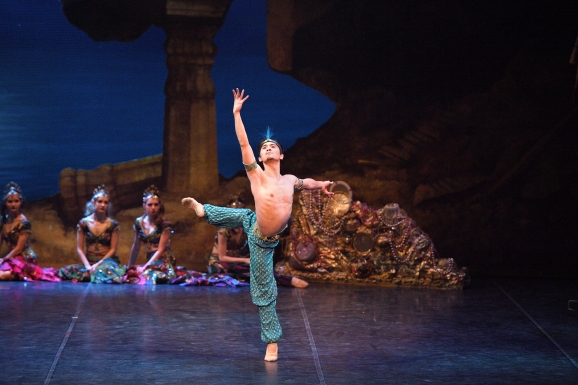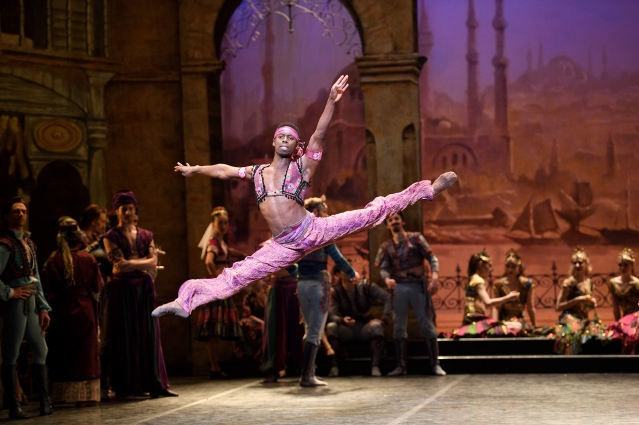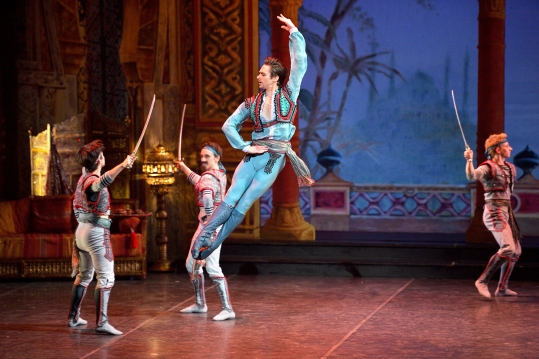This month Julia and Rosie attended two performances of English National Ballet’s (ENB) Le Corsaire at the London Coliseum. This production, first staged in 2013 for ENB by Anna-Marie Holmes remains the only production of the ballet performed by a British company, although both the Mariinsky and Bolshoi companies have performed their productions in London.
Le Corsaire is a preposterous tale of swashbuckling pirates, an avaricious slave trader, lascivious pasha, and the love of Medora, and Conrad, the Pirates’ Captain. Originally choreographed in 1856 by Joseph Mazilier and loosely based on Lord Byron’s 1824 The Corsair, it is a product of its time – a spectacular fantasy of romance and adventure set in the Ottoman Empire, complete with an onstage shipwreck. It also now includes some of the most beautiful and exciting choreography in the classical repertoire.
There were lots of possible topics of conversation raised in reviews by Emma Byrne, Mark Monahan, Graham Watts, Lyndsey Winship, for example, but we found ourselves repeatedly drawn to the subject of the dancing itself and individual dancers’ styles and interpretation of character.

JULIA: So, this was the first time I’ve seen the full ballet live, but you’ve seen other productions, haven’t you, Rosie?
ROSIE: Oh yes, I still vividly remember the Mariinsky (at that time called the Kirov) Ballet coming to London in 1988 after an interlude of 18 years and performing their new production. I saw the same cast as on the DVD: Altyai Asylmuratova, Evgeni Neff, Farukh Ruzimatov Yelena Pankova, Konstantin Zaklinsky and Gennadi Babanin. I’d never seen a whole troupe of dancers so explosive, virtuosic and compelling before. It was electrifying. Dance critic John Percival wrote that after seeing it in Paris at the end of 1987 he had raved about it for months before the company brought it to London the following summer (28).
JULIA: I went to the RAD Library this morning and found out that when Rudolf Nureyev staged Le Corsaire pas de deux for Margot Fonteyn and himself in 1962, Peter Williams noted certain technical skills and qualities that set Nureyev apart from “Western” male dancers. He says: “His variation … provided one of those frisson-making occasions – most exciting of all being a series of jumps in a manège in which he turned high in the air with his legs tucked under him. It is the ease, softness and panther-like grace with which he does everything that makes him so different …” (49-51).
ROSIE: But this description reminds me of Jeffrey Cirio’s performance of Ali, Conrad’s friend, on opening night. In the grand allegro sections, he created beautiful clean precise arabesque lines, and after enormous jumps he would land gently, gradually allowing his body to alight. I find this kind of virtuosity exhilarating!

ROSIE: Daniel McCormick as Ali was also spectacular, but had a quite different visual impact – the twist in his torso was so pronounced that he looked two-dimensional. Extraordinary. He won the 2018 Emerging Dancer Competition performing this role, but since then he has definitely refined and developed the stylistic characteristics of Ali. He drew me in like a magnet whenever he was on the stage, even when he wasn’t performing a dance as such.
JULIA: Another thing that I was particularly impressed by was the use of both personal and performance space. All the men were using the far reach space of their kinesphere; it looked like they couldn’t have reached any farther into the space – this added to the sense of power end elevation in their jumps.
ROSIE: Over the last few weeks I have been noticing the advertising poster with Brooklyn Mack as Conrad: it shows exactly this sense of broad kinesphere – breadth and length through the whole body – as well as strength in allegro. For me the hands are super important to the style. All the male dancers were showing openness and energy in their hand positions.

JULIA: Yes, and this was such as a contrast with Erina Takahashi’s use of personal space… As Medora she used a lot of near space making her port de bras look very delicate, which is also representative of her character. Medora seems quite gentle in comparison to her feisty friend Gulnare. I like the journalist Teresa Guerreiro’s description of Shiori Kase in that role as “sassy” and “resourceful”.
ROSIE: But I think we both found the personalities reversed with the other cast. Katja Khaniukova’s Medora was more spirited. You felt that was connected to her personal moment style, right?
JULIA: Yes, it’s not just a matter of acting, it’s that she highlights positions at the end of a phrase, and this gives her dancing a kind of boldness that makes Medora seem more assertive.
ROSIE: To be honest, when I watch this ballet, I don’t really pay much attention to the story line, as such. Nineteenth century ballets like Giselle (Coralli/Perrot, 1842), Sleeping Beauty (Petipa, 1890) and Swan Lake (Petipa/Ivanov, 1895) seem to hold a lot more symbolic significance within their narratives. But even still, the characters have to have life … Yes, for this ballet to work, the dancing has to be glorious and the acting has to resonate with me.
JULIA: I know what you mean about the libretto, but as I was watching I was seeing important themes emerge, like loyalty, betrayal, compassion. All of them tell us something about human nature. And I always think that the dancers in this Company are really convincing with their acting – even if they have a minor role or are milling around, like in the market scene in Act I of this ballet.
ROSIE: They are! When Jeffrey was performing Conrad, I was so captivated by his “conversation” with Birbanto, his second-in-command, at the side of the stage that I got distracted from the centre-stage dancing!
JULIA: You can even see this commitment to portraying character in the photos – people watching onstage events, showing their interest in different ways, engaging with other characters in really vivid ways, going about their business and so forth. It’s like people watching.
ROSIE: So I was really surprised when I read that Anna-Marie Holmes found teaching the mime the biggest challenge of staging the work. That makes me really appreciate what a skill it is.

JULIA: I know that the Odalisques pas de trois is one of your favourite parts …
ROSIE: I love it!
JULIA: Even here, where the dancers might focus solely on their technique, I noticed on the first night a true sense of character coming through. Julia Conway (she’s such a beautiful dancer – another winner of Emerging Dancer) seemed quite solemn, whereas Precious Adams appeared more agitated about her fate …

ROSIE: And Alison McWhinney was gently glowing, as if indulging in the sheer pleasure of dancing. I always admire her lovely neck line …But I want to go back to the male roles, because the two other male lead roles were performed by dancers that I don’t know at all well: Francesco Gabriele Frola as Conrad, and Erik Woolhouse as the scheming Birbanto.

JULIA: They were both a revelation to me too. They performed with such gusto and energy. I heard you whoop at their elevation.
ROSIE: Birbanto is a much more compelling character for me, though. When Erik Woolhouse slashed his way through the air it spoke of Birbanto’s personality as well as technical bravura. Erik really nailed it in both ways – he was on fire!

JULIA: As Jane Pritchard, ENB’s Archive Consultant, says, Le Corsaire “is a production that allows dancers the opportunity to display virtuosity and personality”.
ROSIE: Hear, hear!
© British Ballet Now & Then
References
Guerreiro, Teresa. “ENB’s Le Corsaire Dazzles at the Coliseum”. Culture Whisper, 9 Jan. 2020, http://www.culturewhisper.com/r/dance/enb_le_corsaire_coliseum/14728. Accessed 10 Jan. 2020.
Holmes, Anna-Marie. “Conversation with Anna-Marie Holmes”. Le Corsaire. Programme. English National Ballet, London Coliseum, 2020.
Percival, John. “Recollections of Summer’s Rapture”. Dance and Dancers, no. 455, 1988, pp. 26-28.
Pritchard, Jane. “The Creation of Le Corsaire”. Le Corsaire. Programme. English National Ballet, London Coliseum, 2020.
Williams, Peter. “London: Ballerina and Pirate 1”. Dance and Dancers, vol. 13, no. 12, 1962, pp. 49-51.

It reminds me of Carlos Acosta’s interpretation in Le Corsaire.
LikeLike
Love Carlos 🙂
LikeLiked by 1 person